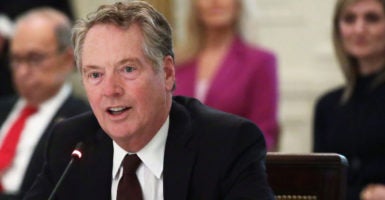Ambassador Robert Lighthizer, the U.S. chief trade negotiator, will testify Wednesday before the House Ways and Means Committee and the Senate Finance Committee. He is expected to defend the Trump administration’s trade agenda since 2017 and shed light on what Congress can expect the future goals of the Trump administration to be on trade.
Lighthizer gave Congress a look at what might be to come in his recent piece in Foreign Affairs, in which he proposed a worker-focused trade policy for the U.S.
It is a unique time for Congress to have the opportunity to hear from and question Lighthizer.
The United States-Mexico-Canada Agreement is set to go into effect July 1.
The success of the Phase 1 deal with China is largely being questioned because recent trade numbers show that China is not on trend to meet its 2020 purchasing commitments.
Members of Congress also continue to question President Donald Trump’s use of certain trade laws to impose tariffs unilaterally.
The future of the World Trade Organization remains uncertain now that its appellate body is unable to function.
Meanwhile, the Office of the United States Trade Representative has formally notified Congress on trade negotiations with the United Kingdom, the European Union, and Kenya.
There will be quite a lot of ground to cover. Here are five questions that should not go unanswered:
- Preserving the World Trade Organization dispute settlement system, as well as advancing new multilateral negotiations to lower trade barriers, is crucial. Obviously, the World Trade Organization is in need of some reform, but the U.S. has been largely absent in efforts to advance reforms. What specifically would the Trump administration like to see reformed?
- America needs a trade policy that puts the needs and freedoms of individuals first, rather than those of special-interest groups. You describe a need to preserve a certain type of work in America while questioning the value brought by the service sector with your worker-focused trade policy. How does that policy promote competition, efficiency, and prosperity for all Americans?
- It is very clear that tariffs on imports from China are not working to affect change in the country’s economic system. Meanwhile, Americans have paid $53 billion in extra taxes due to these tariffs. Why are Americans still paying these tariffs, and what is the administration’s plan to remove or reduce them?
- The administration is running against a tight negotiation timeline with the United Kingdom, the European Union, and Kenya, given that the current Trade Promotion Authority expires next summer. How are talks going and what timeline is the administration thinking for reaching a final agreement with these countries by mid-next year?
- The United States-Mexico-Canada Agreement goes into effect in two weeks. Are things on track for implementation? Can you please walk us through how the administration is handling the new rules of origin requirements and their implementation?
At the end of the day, U.S. trade policy should be geared toward increasing the freedom of individuals to buy and sell with the world, free from government intervention.
These hearings, which take place annually, are a great way for Congress to exercise oversight over the executive branch and remind the administration that the power to regulate trade lies with Congress.





























